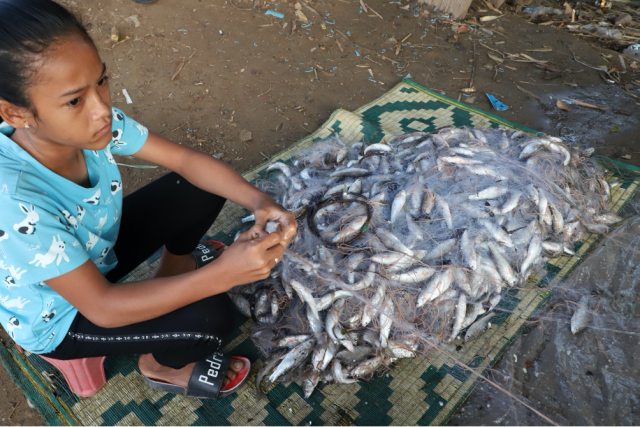Fish: New Expensive Protein in Cambodia

- By Chhut Chheana / USAID Wonders for the Mekong
- July 17, 2021 12:16 PM
In Cambodian society there is an old saying: “Where there is water, there is fish”. The saying suggests that fishery resources in Cambodia are truly abundant, from past to present.
In fact, in the 1980s–1990s, the country’s flooded forests, which are key spawning grounds for fish, were more abundant because they had not been cleared for agriculture. Modern and illegal fishing gear practices were also more rare. Because of this, plentiful fish species were found in streams, ponds, lakes, and rivers, and fish were cheaper to buy than meat in the markets (such as pork, chicken, beef, buffalo meat, or horse meat).
Back then, Cambodian people often preferred fish over meat, especially those who lived in the countryside or had little money to spare. However, rich Cambodian people loved eating meat and preferred it over fish. This choice of protein was an unspoken symbolic definition of status in Cambodian society.
Today, due to overfishing, loss of habitats, and the use of many modern and illegal fishing gears, the fishery resources in Cambodia have dramatically declined, forcing the price of both big and small fishes to increase at a remarkable rate. Because of the hike in fish prices, rural and poorer families have had to resort to replacing fish with meat for their protein source. Even still, their choices are limited. Based on affordability, people can only buy a small quantity of meat, about 200-300 gram or half a kilogram of meat. A kilogram of meat costs about 28,000 riel for pork or 45,000 riel for beef. However, a kilogram of wild-caught fish can range from 30,000–100,000 riel, with some costing up to 400,000 riel per kilo, depending on the size of the fish.
Coincidently, the rich are buying the more pricey fish as a substitute protein for the meat that has recently become cheaper. They think that wild fish from the river are good for their health and are free of the chemical substances used in fish farming.
The Wonders of the Mekong project encourages all fishers to only use fishing gear approved by the fisheries law, and calls for people living near streams, lakes, and rivers to protect flooded forests. By protecting the flooded forests, you are also protecting the fish that spawn there, preventing further decline of fisheries resources. You can be part of the solution! Remember, this is for all of us and for future generations.
Please share this post and follow Wonders of the Mekong to learn more about fisheries resources in Cambodia.















